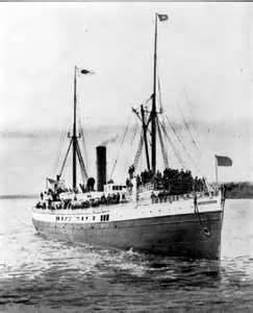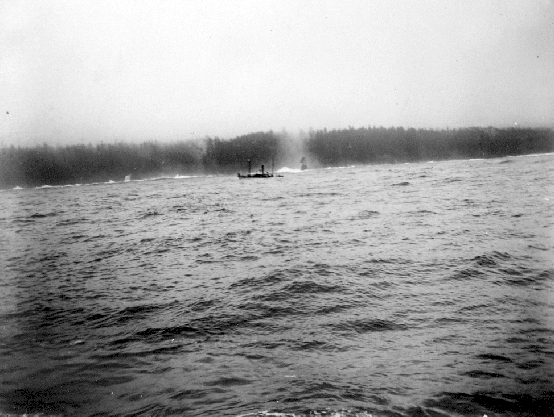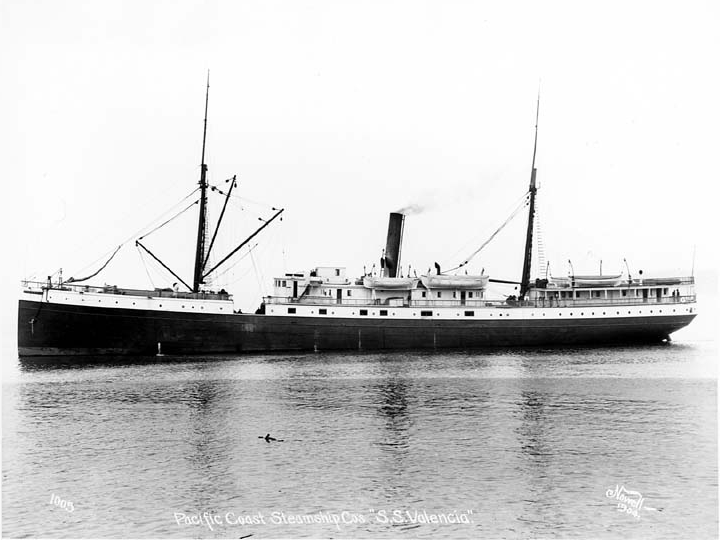SS Valencia
by Andy Hagerty

In 1882 William and sons laid down the keel that would become the iron hulled
passenger Steamer that would become known as the SS Valencia. She was built as
a passenger ship to sail the passenger route between California and Alaska.
Little did anyone who worked upon her in the yards foresee the horrors that
would one day happen upon her.
One bright sunny day in 1906 the SS Valencia set off from the city of San
Francisco. The ship was not on her normal route. Her Sister ship the SS Pueblo
was in the yards so she took over the San Francisco to Seattle run. She set off
on January 20th, her and her 65 crew and at least 108 passengers set
of to destiny. Things were going well, up till the early morning hours on the
21st when the weather took a turn for the worse off cape Mendocino in
northern California.
passenger Steamer that would become known as the SS Valencia. She was built as
a passenger ship to sail the passenger route between California and Alaska.
Little did anyone who worked upon her in the yards foresee the horrors that
would one day happen upon her.
One bright sunny day in 1906 the SS Valencia set off from the city of San
Francisco. The ship was not on her normal route. Her Sister ship the SS Pueblo
was in the yards so she took over the San Francisco to Seattle run. She set off
on January 20th, her and her 65 crew and at least 108 passengers set
of to destiny. Things were going well, up till the early morning hours on the
21st when the weather took a turn for the worse off cape Mendocino in
northern California.
|
With an almost human scream the ship tore into the reefs, The crew
immediately reacted, backing the ship off the rocks. The damage control parties reported a huge gash in her bow into which the cold waters of the pacific were rapidly pouring. The Captain quickly ordered her run aground as there was no way the crew could save her. She came to rest 50 feet from the shore in heavy storm tossed surf. In the confusion that followed, six of the seven life boats were lowered before the captain gave the order. Three flipped over while being lowered, spilling their human cargo into the merciless sea. Two of the remaining three boats capsized immediately sending their occupants to the same fate as the first three. One boat made it away. The scene was one of noise confusion and horror as Frank Lehn, one of the few survivors, would later recount: “Screams of women and children mingled in an awful chorus with the shrieking of the wind, the dash of rain, and the roar of the breakers. As the passengers rushed on deck they were carried away in bunches by the huge waves that seemed as high as the ship's mastheads. The ship began to break up almost at once and the women and children were lashed to the rigging above the reach of the sea. It was a pitiful sight to see frail women, wearing only night dresses, with bare feet on the freezing ratlines, trying to shield children in their arms from the icy wind and rain.” |
This is a shot on January 23, 1906 of the stranded SS Valencia from the decks of on of the ships standing off unable to provide assistance.
|
Twelve men made it to shore, but their ordeal was not over. Three were swept back into the howling sea. They were never heard from again. The remaining nine scaled the sea cliffs and set out for help. Later they would be criticized for not attempting to set up rescue lines with the grounded ship.
Of the last remaining lifeboat, the ships Boatswain and a crew of volunteers went to shore to see what they could do for the passengers. Upon
reaching the shore they found a trail and sign that put them three miles from cape Beale. They set out on a two and a half hour forced march to get the lighthouse. Upon arrival, the lighthouse keeper phoned the town, but the news had already been passed as the group of nine men had found a telegraph line and followed it to a lineman’s hut. The Boatswain and his party were still frantic as they thought of the last sight they had of the ship and crew “the brave faces looking at them over the broken rail of a wreck and of the echo of that great hymn sung by the women who, looking death smilingly in the face, were able in the fog and mist and flying spray” The hymn that floated over the noise and confusion as the dying ship receded into the black? - Nearer, My God to Thee.
Three ships raced out into he dark night. On the morning of the 24th, the SS Queen reached the disaster site. The weather was too
severe to reach the stranded ship, so the Queen maintained station out to sea. A rescue party went overland through the wilderness to affect a rescue from the shore. There were two remaining lifeboats on the ship were launched, but the majority of the passengers chose to stay aboard. They believed their salvation was at hand. Fate, however had other plans.
“When the overland party arrived at the cliffs above the site of the wreck, they found dozens of passengers clinging to the rigging and the few unsubmerged
parts of the Valencia's hull. Without any remaining lifelines, however, they could do nothing to help the survivors, and within hours a large wave washed the wreckage off the rocks and into the ocean. Every remaining passenger drowned.”
The SS City of Topeka arrived and searched for survivors. They found one of the two life rafts with 18 men onboard. The second life raft eventually drifted to shore near Barkley Sound with four survivors. Although the death toll varies as high as 187, the official number is 137 persons. Not one of the woman or children onboard was among the 37 survivors.
Five months after the disaster, a fisherman claimed he had found a life raft with 8 skeletons in it in a nearby cave. Although a salvage party went out to retrieve the raft, no one was able to locate it.
In 1910, it was reported in the Seattle times that a ship that was the SS Valencia was spotted off of Pachena point. Sailors still claim today, that they can see the specter of the steamer drifting near the reef in Pachena Point, and remains the source of frequent wild theories and ghost ship sightings.
In 1933, Lifeboat #5 was found floating peacefully Barkley Sound. Remarkably, it was in good condition with much of the original paint remaining. There was no sign of survivors onboard. This is the boat that was launched in the beginning of the disaster that went missing. The lack of survivors way be attributed to the fact that if was found 27 years after the fateful night.
To be fair, we at night watch paranormal must admit this is more of a Ghost lifeboat tale then a full ghost ship tale. The oddity of a small boat, in a well traveled waterway drifting around for 27 years in an area of famously harsh winters and horrific storms is truly mysterious. If you happen to be up in Victoria, British Columbia you can see a part of this mystery. The boat's nameplate is now on display in the Maritime Museum of British Columbia. If you go, give a moment of silence to the doomed passengers of the ship, maybe that will help to ease those restless sprits and allow them to rest.
Of the last remaining lifeboat, the ships Boatswain and a crew of volunteers went to shore to see what they could do for the passengers. Upon
reaching the shore they found a trail and sign that put them three miles from cape Beale. They set out on a two and a half hour forced march to get the lighthouse. Upon arrival, the lighthouse keeper phoned the town, but the news had already been passed as the group of nine men had found a telegraph line and followed it to a lineman’s hut. The Boatswain and his party were still frantic as they thought of the last sight they had of the ship and crew “the brave faces looking at them over the broken rail of a wreck and of the echo of that great hymn sung by the women who, looking death smilingly in the face, were able in the fog and mist and flying spray” The hymn that floated over the noise and confusion as the dying ship receded into the black? - Nearer, My God to Thee.
Three ships raced out into he dark night. On the morning of the 24th, the SS Queen reached the disaster site. The weather was too
severe to reach the stranded ship, so the Queen maintained station out to sea. A rescue party went overland through the wilderness to affect a rescue from the shore. There were two remaining lifeboats on the ship were launched, but the majority of the passengers chose to stay aboard. They believed their salvation was at hand. Fate, however had other plans.
“When the overland party arrived at the cliffs above the site of the wreck, they found dozens of passengers clinging to the rigging and the few unsubmerged
parts of the Valencia's hull. Without any remaining lifelines, however, they could do nothing to help the survivors, and within hours a large wave washed the wreckage off the rocks and into the ocean. Every remaining passenger drowned.”
The SS City of Topeka arrived and searched for survivors. They found one of the two life rafts with 18 men onboard. The second life raft eventually drifted to shore near Barkley Sound with four survivors. Although the death toll varies as high as 187, the official number is 137 persons. Not one of the woman or children onboard was among the 37 survivors.
Five months after the disaster, a fisherman claimed he had found a life raft with 8 skeletons in it in a nearby cave. Although a salvage party went out to retrieve the raft, no one was able to locate it.
In 1910, it was reported in the Seattle times that a ship that was the SS Valencia was spotted off of Pachena point. Sailors still claim today, that they can see the specter of the steamer drifting near the reef in Pachena Point, and remains the source of frequent wild theories and ghost ship sightings.
In 1933, Lifeboat #5 was found floating peacefully Barkley Sound. Remarkably, it was in good condition with much of the original paint remaining. There was no sign of survivors onboard. This is the boat that was launched in the beginning of the disaster that went missing. The lack of survivors way be attributed to the fact that if was found 27 years after the fateful night.
To be fair, we at night watch paranormal must admit this is more of a Ghost lifeboat tale then a full ghost ship tale. The oddity of a small boat, in a well traveled waterway drifting around for 27 years in an area of famously harsh winters and horrific storms is truly mysterious. If you happen to be up in Victoria, British Columbia you can see a part of this mystery. The boat's nameplate is now on display in the Maritime Museum of British Columbia. If you go, give a moment of silence to the doomed passengers of the ship, maybe that will help to ease those restless sprits and allow them to rest.


